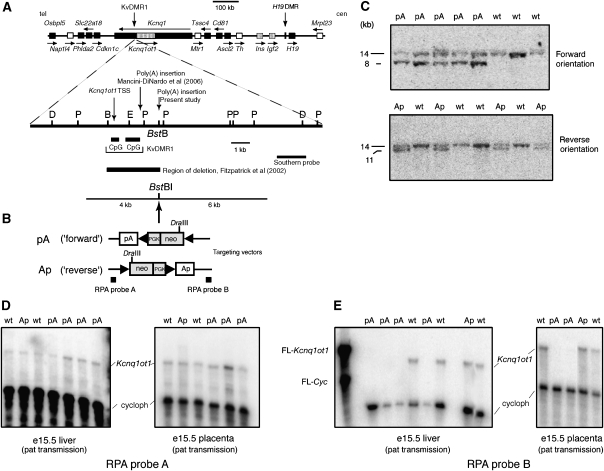Figure 1.
Physical map of the imprinted domain in distal chromosome 7, targeting strategy for insertion of poly(A) cassette in KvDMR1, and effect of insertion on Kcnq1ot1 expression. (A) Upper diagram: Genomic map showing the location of imprinted genes in mouse distal chromosome 7. Maternally expressed genes are indicated as black boxes, paternally expressed genes as stippled boxes, and non-imprinted (biallelic) genes as white boxes. Arrows above or below each gene indicate the direction of transcription. tel, telomere; cen, centromere. Lower diagram: An enlargement of the mouse KvDMR1 locus and flanking DNA showing the location of the two adjacent CpG islands and the position of the BstBI site into which the poly(A) cassette was inserted. B, BsrGI; D, DraIII; P, PstI, E, EagI. The positions of the Kcnq1ot1 transcription start site (TSS), as well as the insertion locations for poly(A) truncation cassettes use in this study and in the Mancini-Dinardo et al (2006) report, are indicated. (B) Schematic representation of the insertion vector showing the extent of the left-hand (6 kb) and right-hand (4 kb) homologous regions used for recombination. The ‘floxed' neomycin-resistance gene (neo) is driven by the Pgk promoter and contains an SV40 polyadenylation site. The SV40 polyadenylation site results in the introduction of an additional DraIII site, which facilitates genotyping the ES cell-derived mice by Southern hybridization. The rabbit β-globin poly(A) cassette was ligated to the neo-cassette and the resultant fragment inserted into the BstBI site in either forward (pA) (i.e., same orientation as Kcnq1ot1 transcript) or in reverse orientation (Ap). The extent of the deletion described by Fitzpatrick et al (2002) and the positions of the Southern and RPA probes are indicated. (C) Southern hybridization to genomic DNA digested with DraIII from fetuses derived from agouti colored chimeric males and C57BL/6J females. (D, E) Following excision of the neo-cassette by mating with female Zp3-cre mice, the effect of the poly(A) cassette on the expression of the Kcnq1ot1 ncRNA was determined by RPA using RNA from e15.5 conceptuses (liver and placenta) following paternal transmission of the poly(A) cassette (pA or Ap) and wt littermates. The positions of the cyclophilin and Kcnq1ot1 full-length probes (FLP) and protected probes are indicated.

